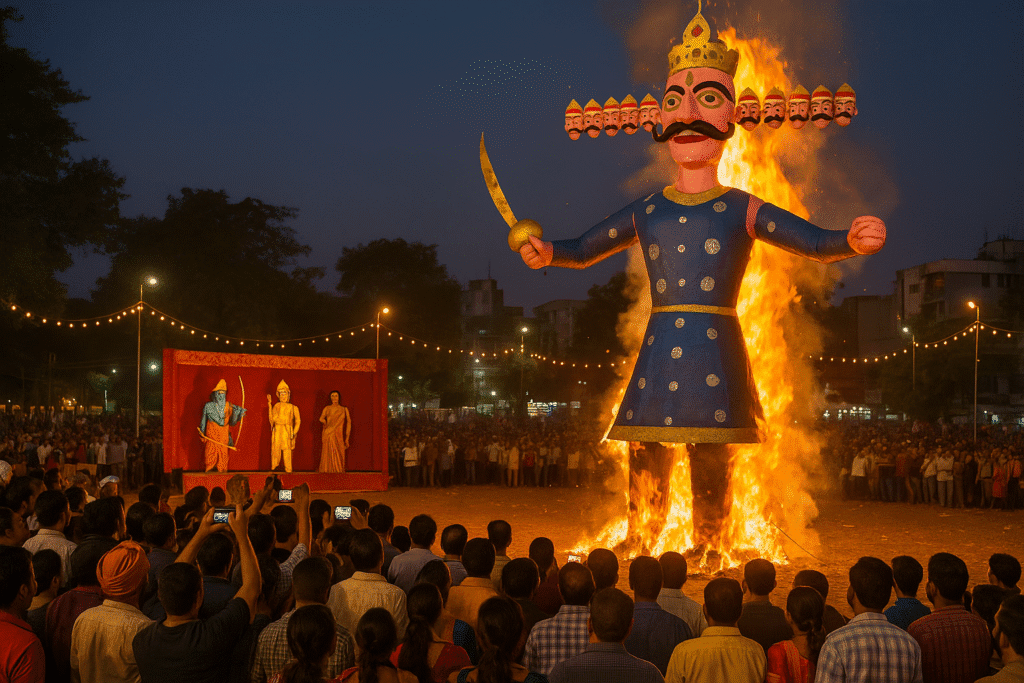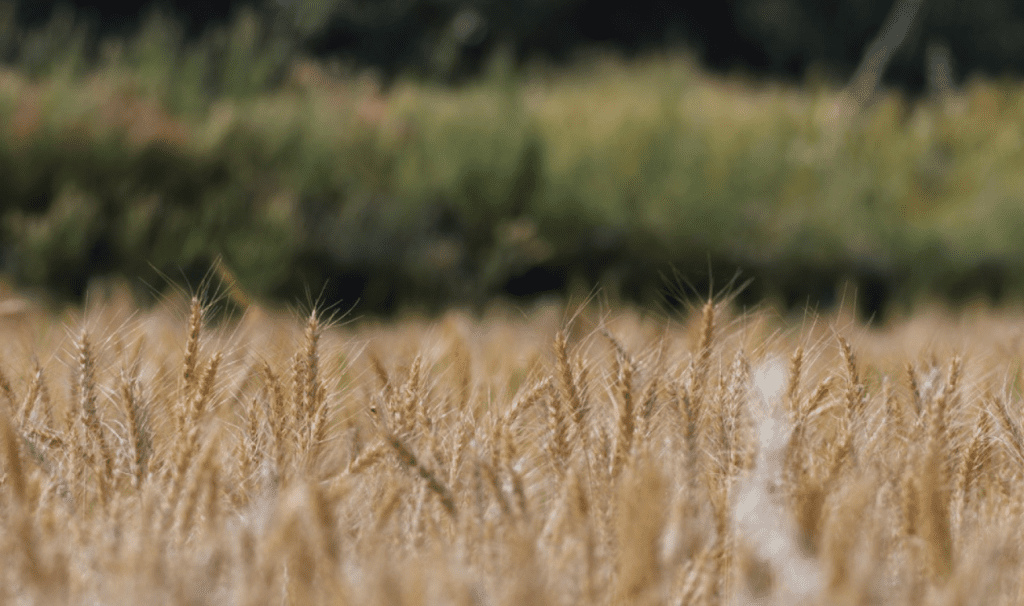Introduction: A Festival of Triumph and Renewal
Dussehra, also known as Vijayadashami, is one of India’s most vibrant and revered festivals, marking the triumph of good over evil. Celebrated on the tenth day of the Hindu month of Ashwin (September–October), Dussehra concludes the nine-day Navratri festival with a spectacular display of devotion, cultural performances, and communal joy. Rooted in the epic Ramayana, it commemorates Lord Rama’s victory over the demon king Ravana, symbolizing righteousness prevailing over malevolence. From the towering effigy burnings of North India to the intricate rituals of South India, Dussehra unites diverse communities in a shared celebration of virtue and renewal. This article explores the historical significance, rituals, regional variations, and modern evolution of Dussehra, capturing its timeless resonance across India and beyond.
Historical and Spiritual Significance
Mythological Foundations: The Ramayana Legacy
Dussehra’s core narrative stems from the Ramayana, where Lord Rama, aided by his wife Sita, brother Lakshmana, and devotee Hanuman, defeats Ravana, the ten-headed demon king of Lanka. This victory, celebrated on the tenth day, signifies the restoration of dharma (righteousness). Another legend ties Dussehra to Goddess Durga’s triumph over the buffalo demon Mahishasura, marking the culmination of Navratri. For some communities, it also honors Arjuna’s victory in the Mahabharata, as he retrieved his weapons on this day. These stories converge on a universal theme: the eternal triumph of good over evil, making Dussehra a festival of moral and spiritual renewal.
A Celestial Milestone
Dussehra falls on the tenth day (Dashami) of the bright half of Ashwin, aligned with the lunar calendar, typically in late September or early October. In 2024, it was celebrated on October 12, following Navratri’s nine nights of worship. The day is considered highly auspicious, believed to amplify the success of new ventures, learning, and spiritual pursuits. Ancient texts like the Devi Bhagavata Purana emphasize Vijayadashami as a time to honor wisdom, courage, and divine feminine energy, embodied by Durga and Rama’s valor.
Rituals and Traditions: A Tapestry of Devotion
Ramlila: The Epic Enacted
In North India, Dussehra is synonymous with Ramlila, a dramatic reenactment of the Ramayana performed over ten days. Communities stage vibrant plays in open grounds, with actors portraying Rama, Sita, and Ravana. The finale on Dussehra features the burning of massive effigies of Ravana, Kumbhakarna, and Meghnad, stuffed with fireworks, symbolizing the destruction of evil. Iconic Ramlilas, like those in Delhi’s Ramlila Maidan and Varanasi’s Ramnagar, draw thousands, blending devotion with theatrical grandeur. In 2024, eco-friendly effigies made with biodegradable materials gained traction, reflecting environmental consciousness.
Durga Visarjan: Farewell to the Goddess
In East and South India, Dussehra marks the immersion (visarjan) of Goddess Durga’s idols, concluding Navratri. In West Bengal, intricately crafted Durga pandals are dismantled, and idols are immersed in rivers or seas, accompanied by sindoor khela, where married women smear vermilion on each other, celebrating feminine power. In Odisha and Karnataka, the focus shifts to Saraswati and Lakshmi puja, with books and tools worshipped to invoke wisdom and prosperity. These rituals, rich in regional flavor, underscore Dussehra’s multifaceted spiritual significance.
Ayudha Puja and Vidyarambham: Honoring Tools and Learning
In South India, particularly Karnataka, Tamil Nadu, and Kerala, Dussehra is celebrated as Ayudha Puja, where tools, weapons, and books are cleaned, decorated with sandalwood paste and flowers, and worshipped. Farmers honor plows, artisans their tools, and students their books, seeking divine blessings for success. In Kerala, Vidyarambham introduces young children to learning, with priests or elders guiding them to write their first letters on rice or sand, symbolizing the start of education. These rituals highlight Dussehra’s role as a day of beginnings and reverence for knowledge.
Regional Variations: A Kaleidoscope of Celebrations
North India: Effigies and Fireworks
In states like Uttar Pradesh, Punjab, and Himachal Pradesh, Dussehra is a spectacle of towering Ravana effigies set ablaze amid fireworks. Kullu Dussehra in Himachal Pradesh, a week-long festival, features a unique procession of deities carried in palanquins, drawing global tourists. The vibrant fairs, with Ferris wheels and food stalls, add a carnival-like atmosphere, making North India’s Dussehra a blend of devotion and festivity.
East India: Durga’s Grand Farewell
In West Bengal, Odisha, and Assam, Dussehra is the emotional climax of Durga Puja. Kolkata’s streets come alive with processions, drumbeats, and tearful farewells as Durga idols are immersed. Community feasts feature bhog (prasad) like khichdi and payesh (rice pudding). In Cuttack, silver and gold filigree tableaux enhance the grandeur, showcasing Odisha’s craftsmanship. These celebrations emphasize communal unity and artistic expression.
South India: Mysore’s Royal Splendor
Karnataka’s Mysore Dussehra is world-famous, rooted in the Vijayanagara Empire’s traditions. The Mysore Palace, illuminated with 100,000 bulbs, hosts a royal procession featuring the goddess Chamundeshwari atop a decorated elephant. Cultural performances, including classical music and dance, draw crowds, while the Jamboo Savari (elephant parade) captivates tourists. In 2024, the 10-day event (October 3–12) celebrated its 414th edition, blending heritage with modernity.
West India: Garba and Community Bonding
In Gujarat and Maharashtra, Dussehra follows Navratri’s Garba and Dandiya dances, with communities gathering for vibrant celebrations. In Ahmedabad, Dussehra includes Ramlila performances and small-scale effigy burnings, while Mumbai hosts cultural fairs. The festival’s communal spirit, marked by shared meals and dance nights, fosters social cohesion, reflecting Western India’s festive exuberance.
Cultural Performances: Art and Tradition in Harmony
Ramlila and Folk Arts
Beyond Ramlila, Dussehra features folk performances like Tamil Nadu’s Therukoothu (street theater) and Andhra Pradesh’s Burrakatha, narrating epic tales. In North India, Swang and Nautanki troupes perform humorous skits, blending mythology with social commentary. These art forms, often passed down generations, preserve regional languages and storytelling traditions, captivating audiences of all ages.
Music and Dance Extravaganzas
Dussehra melas host classical and folk music, from Hindustani ragas in Varanasi to Karnataka’s Yakshagana dance-drama. In Gujarat, post-Navratri Garba nights extend into Dussehra, with participants in vibrant chaniya cholis dancing to live bands. These performances, set against illuminated pandals or palace backdrops, create a festive synergy, showcasing India’s cultural diversity.
Culinary Delights: A Feast of Festivity
Dussehra’s culinary spread reflects India’s regional diversity. In North India, feasts include puri-aloo, kheer, and jalebi, while Bengali bhog features luchi, cholar dal, and mishti. South Indian households serve dosa, sambar, and payasam, with Mysore’s Dussehra famous for its royal sweets like Mysore pak. In Gujarat, fafda and jalebi are festival staples, paired with spicy chutneys. These dishes, shared with neighbors and offered as prasad, embody Dussehra’s spirit of generosity and abundance.
The Setting: India’s Festive Landscape
Urban and Rural Splendor
Dussehra transforms India’s cities and villages into vibrant arenas. Delhi’s Red Fort grounds and Kolkata’s Kumartuli pandals buzz with crowds, while rural Himachal’s Kullu Valley hosts deity processions. Mysore’s illuminated palace and Varanasi’s ghats, lined with diyas, create a magical ambiance. The festival’s universal appeal ensures every corner of India, from Gujarat’s Garba grounds to Kerala’s temple courtyards, resonates with celebration.
Accessibility and Global Reach
Major Dussehra events in Delhi, Mysore, and Kolkata are accessible via India’s airports and rail networks. For travelers, homestays in Kullu or heritage hotels in Mysore offer immersive experiences. The diaspora celebrates Dussehra in London, New York, and Sydney, with Ramlila performances and cultural fairs. In 2024, virtual streams of Mysore Dussehra and Kolkata’s Durga Visarjan connected global audiences, amplifying the festival’s reach.
Modern Evolution: Balancing Tradition and Sustainability
Eco-Conscious Celebrations
Dussehra’s environmental impact, from effigy burnings and idol immersions, has spurred sustainable practices. In 2024, Delhi mandated green crackers, and Kolkata used biodegradable Durga idols to reduce water pollution. Community clean-ups and tree-planting drives, like those in Mysore, aligned with the festival’s renewal theme. Social media campaigns promoted eco-friendly rangoli and clay idols, ensuring Dussehra evolves responsibly.
A Global and Inclusive Festival
Dussehra’s universal message resonates worldwide, with non-Hindus joining celebrations in multicultural hubs like Toronto and Dubai. In 2024, UNESCO recognized Mysore Dussehra as a cultural heritage event, boosting its global profile. Schools and workplaces host Dussehra events, fostering inclusivity, while online platforms offer virtual pujas and Ramlila streams, connecting the diaspora. The festival’s adaptability ensures it remains relevant across generations.
Dussehra in Context: A Universal Triumph
Shared Themes Across Cultures
Dussehra shares parallels with global festivals like Easter or Eid, celebrating renewal and victory over adversity. Its focus on good over evil aligns with Diwali and Holi, yet its dramatic effigy burnings and regional diversity set it apart. Unlike temple-centric festivals, Dussehra’s community-driven rituals, from Ramlila to Durga Visarjan, make it accessible to all, reinforcing its pan-Indian appeal.
A Celebration of Resilience
Dussehra’s message of triumph inspires resilience, encouraging devotees to overcome personal and societal challenges. During the 2020 pandemic, virtual Ramlilas and scaled-down celebrations kept the spirit alive. The festival’s emphasis on wisdom (Saraswati) and courage (Durga) empowers individuals, making Dussehra a beacon of hope and renewal in turbulent times.
Conclusion: A Timeless Ode to Virtue
Dussehra is more than a festival; it is India’s vibrant ode to the triumph of good over evil, weaving together faith, culture, and community. From the fiery spectacle of Ravana’s effigies to the graceful farewell of Durga’s idols, every ritual pulses with meaning and joy. As families gather, dances swirl, and feasts abound, Dussehra unites India’s diverse tapestry in a shared celebration of righteousness. Whether in a bustling city maidan or a quiet diaspora stage, the festival’s spirit endures, inspiring courage and hope. As we light a diya or cheer the fall of Ravana, Dussehra reminds us to embrace virtue, conquer darkness, and march toward a brighter future, together.



